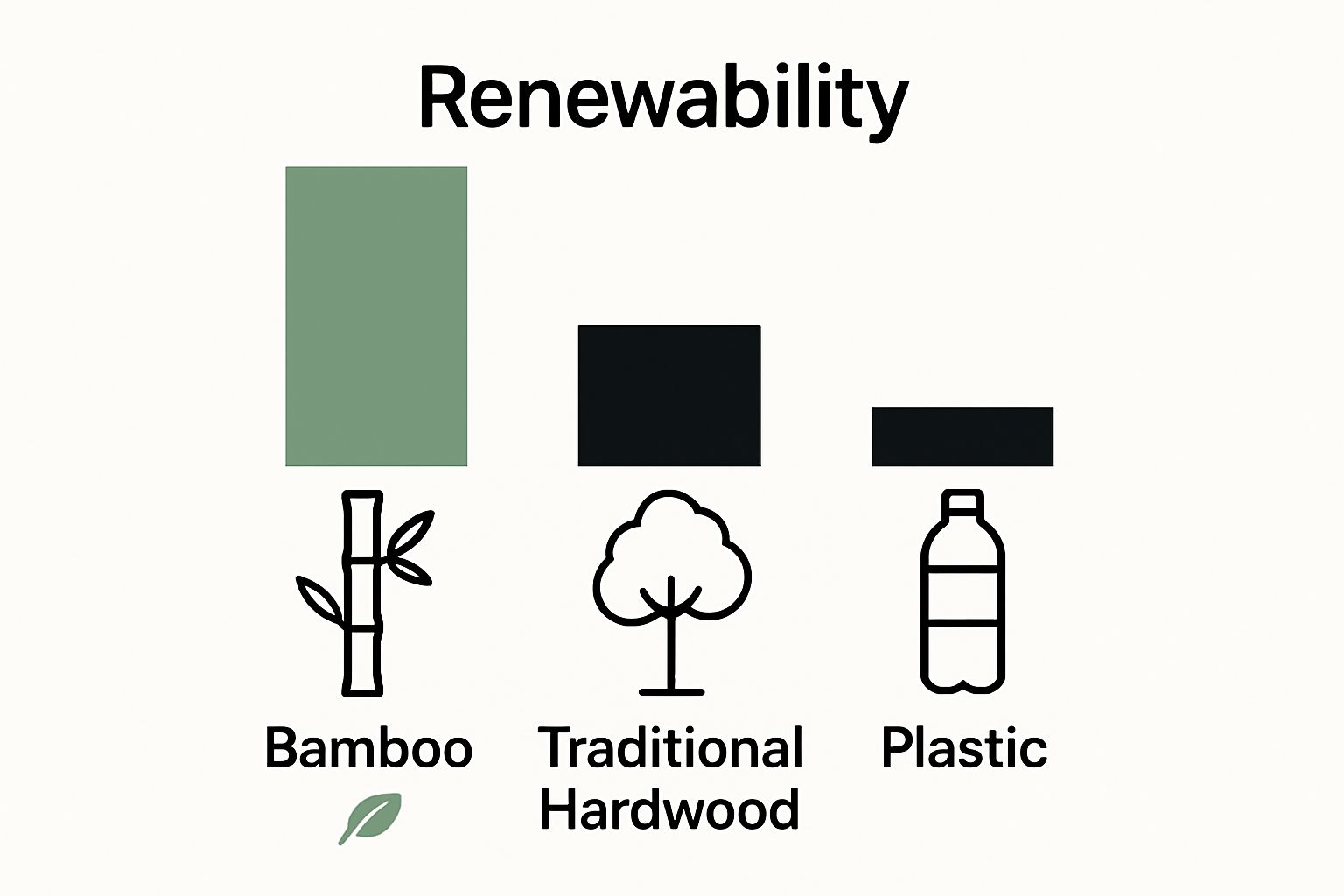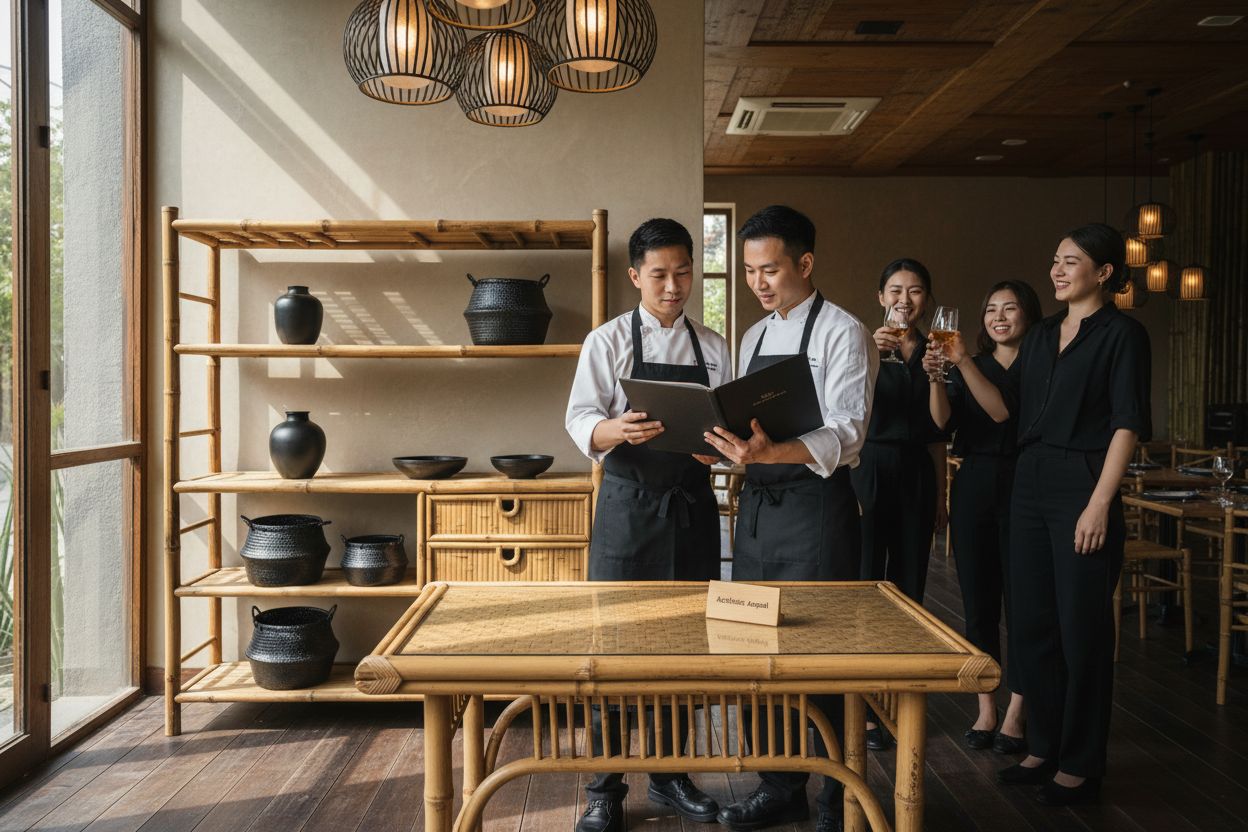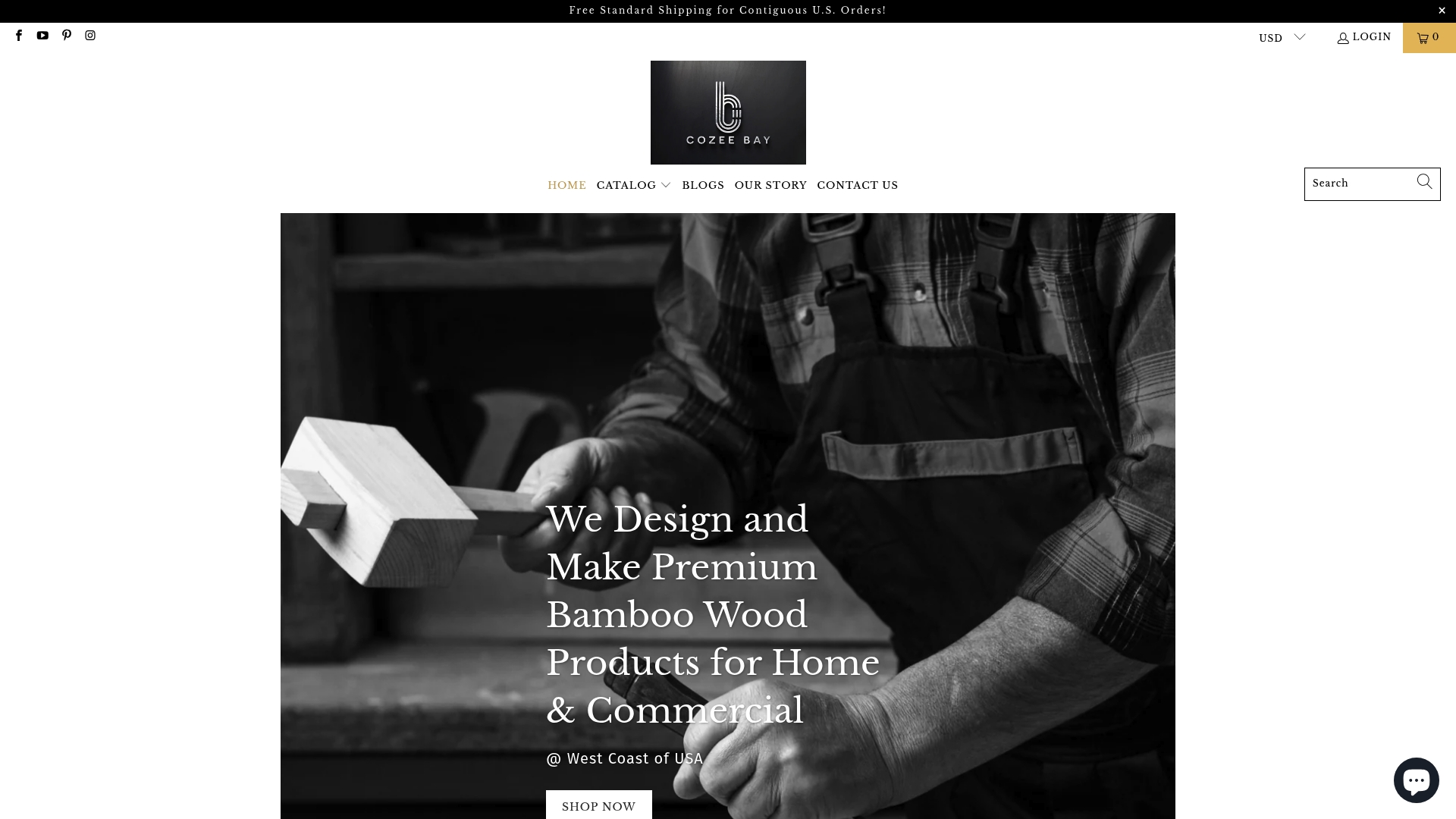Your Cart is Empty
Free Standard Shipping for Contiguous U.S. Orders!
Free Standard Shipping for Contiguous U.S. Orders!
Catalog

Understanding Why Choose Bamboo for Restaurants
October 12, 2025 8 min read
Bamboo is showing up in restaurants everywhere and it is more than just a pretty face. Some species of bamboo can grow up to 3 feet in a single day which makes it one of the fastest renewable resources around. People think it is all about the eco-friendly buzz but the most fascinating part is how bamboo actually outperforms traditional materials in strength, durability, and everyday use.
Table of Contents
- The Benefits Of Bamboo In Restaurant Design
- Why Sustainability Matters In Dining Environments
- How Bamboo Technology Works In Modern Applications
- Exploring The Aesthetic Appeal Of Bamboo In Interiors
Quick Summary
| Takeaway | Explanation |
|---|---|
| Bamboo is an eco-friendly choice | Bamboo grows rapidly, absorbs more CO2, and produces more oxygen, making it sustainable for restaurant design. |
| Offers significant durability and versatility | Bamboo’s strength and resistance to moisture make it ideal for high-traffic environments like restaurants. |
| Enhances brand reputation through sustainability | Embracing bamboo and sustainable practices aligns with consumer expectations and boosts brand perception. |
| Economic benefits of sustainable practices | Implementing bamboo and sustainability can reduce operational costs significantly through energy and waste management. |
| Aesthetic appeal complements various designs | Bamboo adds natural beauty and texture, fitting seamlessly into various design styles, from modern to rustic. |
The Benefits of Bamboo in Restaurant Design
Bamboo represents a transformative material for restaurant design, offering an exceptional combination of sustainability, aesthetic appeal, and practical functionality. Unlike traditional materials, bamboo provides restaurant owners with a versatile solution that addresses multiple design and operational requirements simultaneously.
Sustainability and Environmental Impact
Restaurants increasingly recognize bamboo as a superior eco-friendly design material. This rapidly renewable resource grows significantly faster than traditional hardwoods, with some bamboo species capable of growing up to 3 feet per day. Research from the World Wildlife Fund demonstrates that bamboo absorbs more carbon dioxide and produces 35% more oxygen compared to equivalent tree stands, making it an environmentally responsible choice for conscious restaurateurs.
Key environmental advantages of bamboo include:

- Rapid growth and renewable harvesting cycles
- Minimal water requirements for cultivation
- Natural resistance to pests without chemical interventions
- Biodegradable and recyclable material properties
Functional Design and Durability
Bamboo’s inherent structural properties make it an outstanding material for restaurant environments. Its natural strength rivals steel in tensile performance while remaining lightweight and flexible. Restaurant designers appreciate bamboo’s resistance to moisture, warping, and bacterial growth, which are critical considerations in high-traffic food service spaces.
Moreover, our comprehensive guide on bamboo benefits reveals that bamboo surfaces can withstand intense daily use, maintaining aesthetic quality and structural integrity far longer than many conventional materials. From dining furniture to kitchen accessories, bamboo offers restaurants a durable, elegant solution that combines performance with visual sophistication.
By integrating bamboo into restaurant design, owners demonstrate a commitment to innovative, responsible hospitality that resonates with environmentally conscious consumers seeking authentic, sustainable dining experiences.
To clearly compare bamboo with traditional hardwoods for restaurant use, the following table outlines key sustainability, durability, and environmental performance criteria side by side.
| Feature | Bamboo | Traditional Hardwoods |
|---|---|---|
| Growth Rate | Up to 3 feet per day | Several years to decades |
| Carbon Absorption | Absorbs more, releases 35% more O2 | Lower relative |
| Water Requirements | Minimal | Moderate to high |
| Chemical Treatments Needed | Naturally pest-resistant | Often required |
| Biodegradability | Fully biodegradable | Varies; often less |
| Durability | High – Resists moisture & warping | Can warp/moisture sensitive |
| Aesthetic Qualities | Organic texture, variable tones | Consistent grain, limited |
Why Sustainability Matters in Dining Environments
Sustainability has transformed from a peripheral concept to a critical strategic imperative in restaurant design and operations. Modern dining establishments recognize that environmental responsibility directly impacts their brand reputation, customer perception, and long term operational efficiency.
Consumer Expectations and Environmental Consciousness
Today’s diners are increasingly sophisticated and environmentally aware. Research from the National Restaurant Association reveals that approximately 70% of consumers consider a restaurant’s sustainability practices when selecting dining destinations. This shift represents more than a trend it signals a fundamental change in how restaurants conceptualize their relationship with environmental stewardship.
Key consumer sustainability expectations include:
- Transparent sourcing of ingredients
- Minimal environmental waste generation
- Energy efficient kitchen and dining spaces
- Use of eco-friendly materials and design elements
Economic and Operational Benefits
Contrary to popular misconception, sustainability is not just an ethical choice but a sound economic strategy. Restaurants implementing comprehensive sustainability programs often experience significant operational cost reductions. Our comprehensive guide on sustainable restaurant practices demonstrates that strategic sustainability investments can reduce energy consumption by up to 30% and waste management expenses by 25%.
Sustainable practices create a virtuous cycle where environmental responsibility translates directly into economic advantages. By reducing resource consumption, minimizing waste, and implementing efficient design strategies, restaurants can simultaneously lower operational costs and enhance their market positioning.
Ultimately, sustainability in dining environments represents a holistic approach that balances environmental responsibility, economic pragmatism, and customer expectations. Restaurants that embrace this comprehensive perspective are not just adapting to change they are actively shaping the future of the hospitality industry.
This table summarizes key consumer expectations and economic benefits related to restaurant sustainability, offering a quick reference for why eco-friendly choices like bamboo matter in dining environments.
| Aspect | Key Details |
|---|---|
| Consumer Priority | 70% consider sustainability when choosing restaurants |
| Sourcing Expectation | Transparent, eco-friendly ingredients sourcing |
| Waste Expectation | Minimal environmental waste |
| Energy Efficiency | Energy-saving kitchens and dining spaces |
| Economic Benefit | Up to 30% energy savings possible |
| Waste Management Cost Reduction | Up to 25% lower costs with sustainability |
| Material Expectation | Demand for eco-friendly interior materials |
How Bamboo Technology Works in Modern Applications
Bamboo technology represents a sophisticated fusion of traditional natural materials and cutting edge engineering principles, transforming this ancient grass into a high performance solution for contemporary restaurant design and functionality.
Molecular Structure and Performance Characteristics
Research from Materials Science journals reveals that bamboo’s remarkable performance emerges from its unique cellular composition. Unlike traditional wood, bamboo possesses a complex microstructure characterized by densely packed cellulose fibers and lignin networks that provide extraordinary strength and flexibility.
Key molecular performance characteristics include:
- Exceptional tensile strength comparable to steel
- High flexibility and impact resistance
- Natural moisture and temperature adaptation
- Inherent antimicrobial properties
Advanced Processing and Manufacturing Techniques
Modern bamboo technology involves sophisticated processing methods that enhance the material’s natural properties. Through thermal treatments, chemical modifications, and precision engineering, manufacturers can create bamboo products with specialized performance attributes tailored for specific restaurant environments.
Our guide on bamboo product innovations demonstrates how advanced lamination and compression techniques transform raw bamboo into durable, food safe surfaces that maintain aesthetic elegance while meeting rigorous commercial performance standards.
The intricate transformation from natural grass to high performance material involves multiple precision steps, including fiber extraction, treatment, compression, and finishing. Each stage is meticulously designed to preserve bamboo’s inherent sustainability while dramatically enhancing its functional capabilities for modern restaurant applications.
For readers interested in the functional science behind bamboo, this table breaks down the most important molecular and technological characteristics that enable bamboo to excel in restaurant applications.
| Characteristic | Description |
|---|---|
| Tensile Strength | Comparable to steel, supporting structural integrity |
| Flexibility | High impact resistance & resilience |
| Moisture Adaptation | Naturally resists warping in humid restaurant settings |
| Antimicrobial Nature | Inhibits bacterial growth, ideal for foodservice |
| Processing Techniques | Thermal treatment, chemical modification, compression |
| Final Product | Durable, food-safe, elegant surfaces for restaurants |
Exploring the Aesthetic Appeal of Bamboo in Interiors
Bamboo transcends mere material selection it represents a sophisticated design philosophy that harmonizes natural beauty, texture, and functional elegance in restaurant interior spaces. The aesthetic potential of bamboo offers designers an extraordinary palette of visual and sensory experiences.
Natural Texture and Visual Complexity
Design research from Architectural Digest highlights bamboo’s remarkable ability to introduce organic, nuanced textures that create depth and visual interest in restaurant interiors. Unlike manufactured materials, bamboo presents a living, dynamic visual language characterized by subtle grain variations, warm tones, and intricate natural patterns.
Key aesthetic characteristics of bamboo include:
- Organic grain patterns that vary with each piece
- Natural color gradients ranging from pale honey to rich amber
- Soft yet sophisticated visual texture
- Ability to complement multiple design styles
Design Versatility and Stylistic Expression
Bamboo’s design versatility allows restaurants to craft unique atmospheric experiences. Our comprehensive guide on bamboo decor demonstrates how this material can seamlessly transition between minimalist modernist designs and warm, rustic aesthetic environments.
From sleek bar counters to elegant wall paneling, bamboo offers designers an adaptable medium that can be transformed through different treatments surface finishes and architectural applications.
 Its inherent visual warmth creates inviting spaces that feel simultaneously contemporary and timeless, making it an exceptional choice for restaurants seeking to communicate sophisticated environmental consciousness through their interior design.
Its inherent visual warmth creates inviting spaces that feel simultaneously contemporary and timeless, making it an exceptional choice for restaurants seeking to communicate sophisticated environmental consciousness through their interior design.
The following table organizes the aesthetic and design features that make bamboo a standout choice for restaurant interiors, allowing readers to easily assess its stylistic versatility and appeal.
| Aesthetic Feature | Description |
|---|---|
| Grain Pattern | Organic and unique for every piece |
| Color Range | From pale honey to deep amber |
| Visual Texture | Soft, natural, visually rich |
| Style Compatibility | Adapts well to modern, rustic, or mixed interiors |
| Warmth and Ambiance | Contributes inviting, timeless atmosphere |
| Finish Options | Accepts various treatments for different looks |
Transform Your Restaurant Design with Cozee Bay’s Sustainable Bamboo Solutions
As highlighted in your search for why bamboo is the ideal choice for restaurants, eco-conscious design is no longer an option but a necessity. If you are committed to reducing your environmental footprint while maintaining a stylish atmosphere, Cozee Bay offers the perfect bridge between sustainability and function. Our Bamboo Paper Towel Dispenser brings together the strength, antimicrobial properties, and aesthetic beauty that your hospitality space needs. By upgrading your dining environment with bamboo, you directly address the demand for renewability and long-lasting quality, as mentioned in the article.

Ready to make a lasting impression on your customers and set your restaurant apart as a leader in responsible dining? Visit Cozee Bay now for handcrafted bamboo paper towel dispensers and more. Incorporate sustainable materials that work as hard as you do and experience the confidence that comes from choosing premium solutions crafted for modern commercial use. Take control of your restaurant’s future—explore our Bamboo Paper Towel Dispensers and elevate every touchpoint in your space today.
Frequently Asked Questions
What are the sustainability benefits of using bamboo in restaurant design?
Bamboo is a rapidly renewable resource that grows much faster than traditional hardwoods. By choosing bamboo, restaurants can reduce their environmental impact while promoting an eco-friendly image, appealing to conscious diners.
How does bamboo perform in high-traffic restaurant environments?
Bamboo is exceptionally strong and resistant to moisture, warping, and bacteria, making it ideal for restaurants. Consider incorporating bamboo for dining furniture and functional surfaces to ensure durability and longevity in your space.
What aesthetic qualities does bamboo bring to restaurant interiors?
Bamboo offers unique organic textures and warm tones that create depth and visual interest. Explore various bamboo treatments and finishes to enhance the atmosphere of your restaurant, ensuring a sophisticated design appeal.
How can integrating bamboo contribute to customer satisfaction?
Today’s consumers increasingly prefer dining at establishments that prioritize sustainability and eco-friendliness. By using bamboo, you not only elevate your restaurant’s design but also align with customer values, potentially boosting satisfaction and return visits.
Are there economical advantages to using bamboo in restaurants?
Implementing bamboo can lead to significant cost savings over time, with potential reductions in energy consumption and waste management expenses. Aim for a sustainable design that could decrease operational costs by up to 30% and improve overall efficiency.
What steps can I take to effectively integrate bamboo into my restaurant design?
Start by evaluating the specific areas where bamboo can enhance functionality and aesthetics, such as furniture, decor, and kitchen items. Work with a designer familiar with bamboo to select treatments that complement your restaurant’s style and operational needs.
Recommended
Leave a comment
Comments will be approved before showing up.
Subscribe
Sign up to get the latest on sales, new releases and more …

